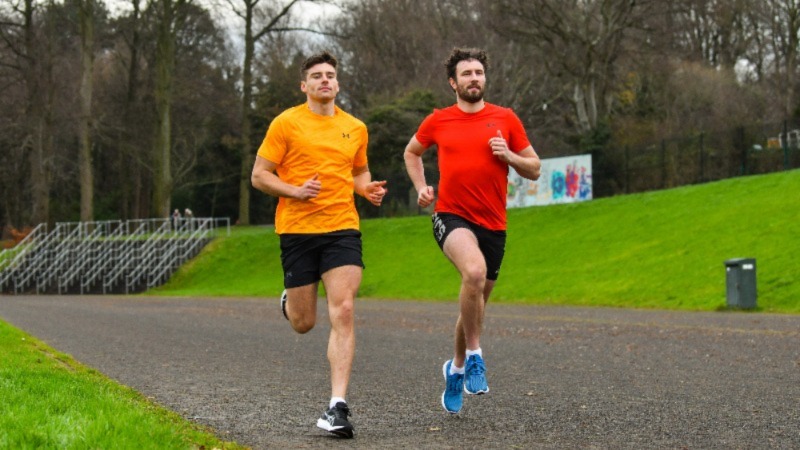Top Running Exercises to Incorporate into Your Training

In August 2021, Danny Quigley took on an astounding 10 in 10 challenge to raise money for local health and wellbeing organisations in memory of his father Colm Quigley. The inspirational challenge consisted of 10 triathlons in 10 days, completing a 2.4 mile swim, 112 mile cycle and a 26.2 mile run each day. Over the 10 days, Danny totalled an incredible 1,406 miles.
Danny spent countless hours training in the months prior to the challenge and has shared some of his top running tips and exercises with us.
Types of Training for Runners
Hitting the pavement regularly and clocking up the miles is only one side to building your endurance and improving your performance. When developing a training plan, you should incorporate strength training and plyometric exercises to improve your running performance.
Strength Training for Runners
Strength training should be considered an important component of your training as it has the potential to decrease your risk of injury. As your muscles become stronger and stability improves, your muscles can absorb more force which in turn minimises the damage to your joints and reduces the possibility of injury.
Your glutes are an important element in the kinetic chain, working to stabilise the hips as you run and extend the hip. Implementing glute strengthening exercises for runners into your programme will aid in reducing side to side motion when running, ensuring the legs, torso and pelvis are aligned. The stronger the glutes, the more power and acceleration in the hip extension and stride which allows you to run faster.
Core muscles also play a large role in your stability while running. Strengthening your core will minimise side movement, helping your posture to remain strong as your body fatigues.
Plyometric Exercises for Runners
Plyometric exercises are designed to train your muscles to work faster with more power so you can increase your speed. These exercises start with a muscle lengthening action (eccentric) followed by a muscle shortening action (concentric), focusing on speedily maximising muscle contractions to increase muscle power. Adding plyometric exercises to your training regime has been found to recruit muscle fibres efficiently which will lead to greater power when running.
Running Exercises to Include in Your Training Programme
Danny suggests including a mix of strength training, plyometric exercises and running in your training regime to build stability, endurance, speed and power. He has demonstrated his top four running exercises in the video below.
1. Reverse Lunges
Reverse lunges are great for activating your glute medius which is one of the most important muscles in relation to increasing speed. While carrying out the exercise, you will need to work on your balance and engage your core to stabilise you. Start with bodyweight reverse lunges and when you get more comfortable, try adding a resistance band or carry a set of dumbbells for extra resistance.
How to do a Reverse Lunge:
- Stand up straight with your feet shoulder-width apart, keeping your shoulders back and core engaged
- Step one leg back and lower your knee until both legs are at 90 degrees
- Press through your front foot and bring your back leg forward again
- Repeat on each leg 10 times
2. Lateral jumps
Lateral jumps are a plyometric exercise designed to improve balance and co-ordination. This movement uses your full body, engaging your lower body including glutes, quadriceps and hamstrings as well as relying on your core muscles for stability.
How to do Lateral Jumps:
- Stand on your right foot with your left foot off the ground and leg slightly bent
- Use your right leg to push off, jumping diagonally and landing on the left foot with the right foot now up
- Repeat 10 times on each leg
3. High Knees
Incorporating high knee drills into your training helps to improve speed. The movement exaggerates the runner’s stride teaching you to raise your knees higher which in turn allows you to hit the ground with more force and run faster. High knees also engage the core, glutes, quadriceps, hamstrings, and calf muscles.
How to do High Knees:
- Stand with your feet hip-width apart
- Stay in the same spot and drive your knee up to waist level quickly
- Place the foot back on the ground and proceed to the other leg
- Ensure to keep a strong posture
- Pump your arms as if you are sprinting
- Alternate legs for one minute
4. Skipping
Skipping is a plyometric exercise used to strengthen leg muscles which helps to increase your speed and reduce the risk of injury. Incorporating jump rope for runners provides a full-body workout which also improves coordination between a runner’s eyes, feet and hands to enhance overall performance.
How to Skip:
- Pick up a skipping rope or jump rope
- Stand facing forward and move the rope forward with your wrists
- Jump over the rope with your two feet simultaneously
- Land softly with slightly bent knees
- Ensure your torso stays stable throughout
Incorporate these running exercises into your training programme for maximum performance. Check out O’Neills Running section for a wide range of training accessories, running shoes, running clothing and running accessories!

